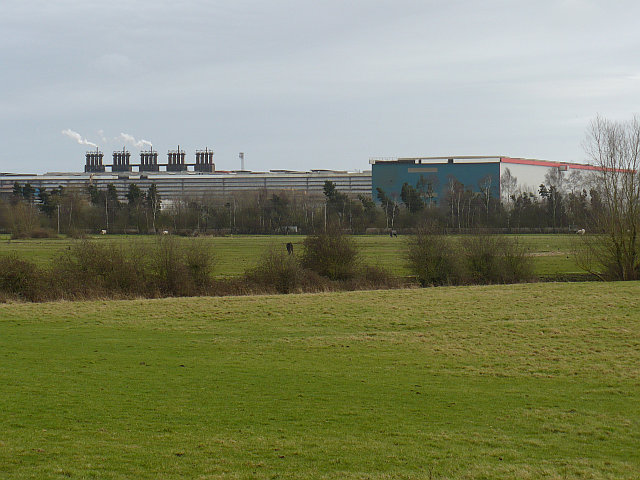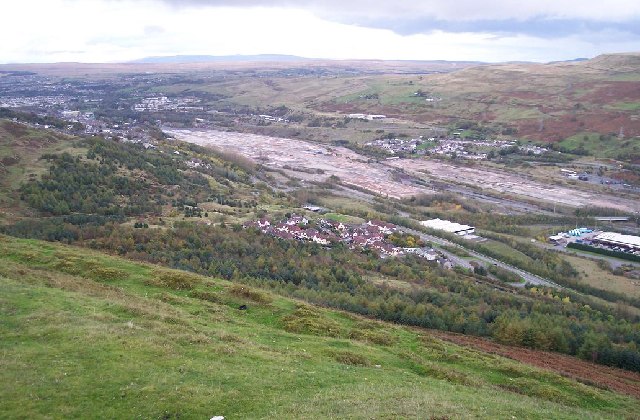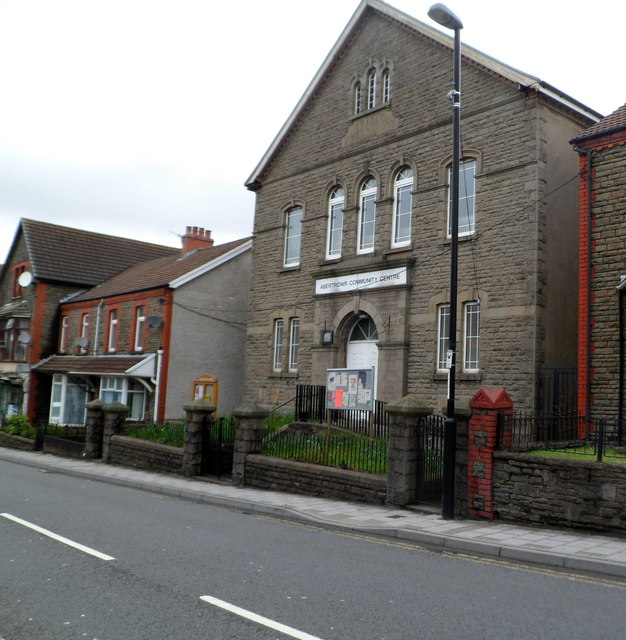|
Nantgarw Colliery
Nantgarw Colliery was a coal mine and later developed Coking coal works, located in the village on Nantgarw, Mid Glamorgan, Wales located just north of Cardiff. Opened in 1910, it closed in 1986. The site is now redeveloped as the industrial estate Parc Nantgarw. Craig Yr Allt Craig Yr Allt Colliery was situated south of Nantgarw village. However, whenever the River Taff flooded, water frequently entered its workings, and it was abandoned in 1878. Development Thomas Taylor of Pontypridd began the development of Nantgarw colliery in May 1910, near the base of the Caerphilly Syncline seam. The sinking of the twin shafts in 1911 reached the coal seam at a depth of more than in 1915, placing them below sea level, making Nantgarw the deepest pit to be sunk in the South Wales Coalfield up to that time. Production Connected to the Rhymney Railway via the Coryton Line, the mine was sold to the Taff Rhondda Navigation Steam Coal Co in 1924. The 850 men were redeployed in 1927 after ge ... [...More Info...] [...Related Items...] OR: [Wikipedia] [Google] [Baidu] |
Coal Mine
Coal mining is the process of extracting coal from the ground. Coal is valued for its energy content and since the 1880s has been widely used to generate electricity. Steel and cement industries use coal as a fuel for extraction of iron from iron ore and for cement production. In the United Kingdom and South Africa, a coal mine and its structures are a colliery, a coal mine is called a 'pit', and the above-ground structures are a ' pit head'. In Australia, "colliery" generally refers to an underground coal mine. Coal mining has had many developments in recent years, from the early days of men tunneling, digging and manually extracting the coal on carts to large open-cut and longwall mines. Mining at this scale requires the use of draglines, trucks, conveyors, hydraulic jacks and shearers. The coal mining industry has a long history of significant negative environmental impacts on local ecosystems, health impacts on local communities and workers, and contributes heavil ... [...More Info...] [...Related Items...] OR: [Wikipedia] [Google] [Baidu] |
Ministry Of Fuel And Power
The Ministry of Power was a United Kingdom government ministry dealing with issues concerning energy. The Ministry of Power (then named Ministry of Fuel and Power) was created on 11 June 1942 from functions separated from the Board of Trade. It took charge of coal production, allocation of fuel supplies, control of energy prices and petrol rationing. These had previously been dealt with by the Secretary for Mines and in the case of petroleum since 1940 by the Secretary for Petroleum. The Petroleum Board, responsible for the coordination of the war-time petroleum 'pool' for oil supplies (except oil for the Royal Navy), continued in this role until the Board was dissolved in 1948. It also took over responsibility for electricity from the Ministry of War Transport and its predecessor the Ministry of Transport. The Ministry of Fuel and Power was renamed the Ministry of Power in January 1957. The Ministry of Power later became part of the Ministry of Technology on 6 Octob ... [...More Info...] [...Related Items...] OR: [Wikipedia] [Google] [Baidu] |
History Of Rhondda Cynon Taf
History (derived ) is the systematic study and the documentation of the human activity. The time period of event before the invention of writing systems is considered prehistory. "History" is an umbrella term comprising past events as well as the memory, discovery, collection, organization, presentation, and interpretation of these events. Historians seek knowledge of the past using historical sources such as written documents, oral accounts, art and material artifacts, and ecological markers. History is not complete and still has debatable mysteries. History is also an academic discipline which uses narrative to describe, examine, question, and analyze past events, and investigate their patterns of cause and effect. Historians often debate which narrative best explains an event, as well as the significance of different causes and effects. Historians also debate the nature of history as an end in itself, as well as its usefulness to give perspective on the problems of the p ... [...More Info...] [...Related Items...] OR: [Wikipedia] [Google] [Baidu] |
Collieries In South Wales
Coal mining is the process of extracting coal from the ground. Coal is valued for its energy content and since the 1880s has been widely used to generate electricity. Steel and cement industries use coal as a fuel for extraction of iron from iron ore and for cement production. In the United Kingdom and South Africa, a coal mine and its structures are a colliery, a coal mine is called a 'pit', and the above-ground structures are a ' pit head'. In Australia, "colliery" generally refers to an underground coal mine. Coal mining has had many developments in recent years, from the early days of men tunneling, digging and manually extracting the coal on carts to large open-cut and longwall mines. Mining at this scale requires the use of draglines, trucks, conveyors, hydraulic jacks and shearers. The coal mining industry has a long history of significant negative environmental impacts on local ecosystems, health impacts on local communities and workers, and contributes heavily t ... [...More Info...] [...Related Items...] OR: [Wikipedia] [Google] [Baidu] |
UK Miners' Strike (1984–1985)
{{disambiguation ...
UK miners' strike may refer to: * UK miners' strike (1893) * South Wales miners' strike (1910) *National coal strike of 1912 * UK miners' strike (1921) * UK miners' strike (1953) * UK miners' strike (1969), a widespread unofficial strike * UK miners' strike (1972) *UK miners' strike (1974), called by Margaret Thatcher * UK miners' strike (1984–85), led by Arthur Scargill of the NUM See also *1926 United Kingdom general strike The 1926 general strike in the United Kingdom was a general strike that lasted nine days, from 4 to 12 May 1926. It was called by the General Council of the Trades Union Congress (TUC) in an unsuccessful attempt to force the Government of the ... [...More Info...] [...Related Items...] OR: [Wikipedia] [Google] [Baidu] |
Coal Briquette
A briquette (; also spelled briquet) is a compressed block of coal dust or other combustible biomass material (e.g. charcoal, sawdust, wood chips, peat, or paper) used for fuel and kindling to start a fire. The term derives from the French word ''brique'', meaning ''brick''. Coal briquettes Coal briquettes have long been produced as a means of using up 'small coal', the finely broken coal inevitably produced during the mining process. Otherwise this is difficult to burn as it is hard to arrange adequate airflow through a fire of these small pieces; also such fuel tends to be drawn up and out of the chimney by the draught, giving visible black smoke. The first briquettes were known as culm bombs and were hand-moulded with a little wet clay as a binder. These could be difficult to burn efficiently, as the unburned clay produced a large ash content, blocking airflow through a grate. With Victorian developments in engineering, particularly the hydraulic press, it became possibl ... [...More Info...] [...Related Items...] OR: [Wikipedia] [Google] [Baidu] |
Port Talbot Steelworks
Port Talbot Steelworks is an integrated steel production plant in Port Talbot, West Glamorgan, Wales, capable of producing nearly 5 million tonnes of steel slab per annum. This makes it the larger of the two major steel plants in the UK and one of the largest in Europe. Over 4,000 people work at the plant. The majority of the slab is rolled on-site at Port Talbot and at the Newport Llanwern site to make a variety of steel strip products. The remainder is processed at other Tata Steel plants or sold in slab form. The works covers a large area of land which dominates the south of the town. Its two blast furnaces and steel production plant buildings are major landmarks visible from both the M4 motorway and the South Wales Main Line when passing through the town. History The site at Margam is made up of a number of plants across a large site, developed since 1901. Port Talbot works The original works were built by Gilbertson, and situated south of Port Talbot railway station. ... [...More Info...] [...Related Items...] OR: [Wikipedia] [Google] [Baidu] |
Llanwern Steelworks
Llanwern steelworks is located in Llanwern, east of the City of Newport, South Wales. History Built for Richard Thomas & Baldwins Ltd, the works was originally referred to locally as "The RTB", before being called Spencer Works and later Llanwern under British Steel Corporation. The steelworks site is alongside the South Wales Main Line east of Newport, offering excellent rail transport for the works. It was the first oxygen-blown integrated steelworks in Britain when it opened in 1962. The hot strip mill pioneered the first successful use of a computer for complete mill control. The steelworks were built on grassland and wetland that local schoolchildren used to roam through on their way to the sea, and which provided a varied habitat for reptiles, amphibians, insects, mammals and birds. Having won an open internal competition in the 1990s with the Ravenscraig steelworks to become British Steel's leading hot strip mill, in the efforts to increase group and site efficiency ... [...More Info...] [...Related Items...] OR: [Wikipedia] [Google] [Baidu] |
Ebbw Vale Steelworks
Ebbw Vale Steelworks was an integrated steel mill located in Ebbw Vale, South Wales. Developed from 1790, by the late 1930s it had become the largest steel mill in Europe. Nationalized after World War II, as the steel industry changed to bulk handling, iron and steel making was ceased in the 1970s, as the site was redeveloped as a specialised tinplate works. Closed by Corus in 2002, the site is being redeveloped in a joint-partnership between Blaenau Gwent Council and the Welsh Government. Development By the mid to late 1700s, the steep-sided wooded valley of the Ebbw Fawr river was called home by a population of around 120, who worked the valley as farmers. But the valley was about to transformed by the Industrial Revolution, by the building of what became Europe's largest steel mill. In 1789, Walter Watkins was the owner of a forge in Glangrwney, near Crickhowell, which lacked an adequate supply of pig iron from the Clydach Ironworks. In agreement with two business partners, ... [...More Info...] [...Related Items...] OR: [Wikipedia] [Google] [Baidu] |
Coke Oven
Coke is a grey, hard, and porous coal-based fuel with a high carbon content and few impurities, made by heating coal or oil in the absence of air—a destructive distillation process. It is an important industrial product, used mainly in iron ore smelting, but also as a fuel in stoves and forges when air pollution is a concern. The unqualified term "coke" usually refers to the product derived from low-ash and low-sulphur bituminous coal by a process called coking. A similar product called petroleum coke, or pet coke, is obtained from crude oil in oil refineries. Coke may also be formed naturally by geologic processes.B. Kwiecińska and H. I. Petersen (2004): "Graphite, semi-graphite, natural coke, and natural char classification — ICCP system". ''International Journal of Coal Geology'', volume 57, issue 2, pages 99-116. History China Historical sources dating to the 4th century describe the production of coke in ancient China. The Chinese first used coke for heating an ... [...More Info...] [...Related Items...] OR: [Wikipedia] [Google] [Baidu] |
Abertridwr, Caerphilly
Abertridwr (; Welsh: ''the mouth of the three waters'') is a village in Caerphilly County Borough, Wales, situated about north-west of Caerphilly town. The "three waters" or "three streams" are Nant Cwm-parc, Nant Cwmceffyl and Nant Ilan, which join to form Nant yr Aber. Like many villages and towns in the area, Abertridwr was a coal mining community within the South Wales Coalfield. Windsor Colliery In 1895 the Windsor Colliery Company started to sink two shafts to a depth of around 2018 feet (615 m). The first coal was raised in 1902, The workings were connected underground to the Universal Colliery in Senghenydd for ventilation purposes. On 1 June 1902, a platform collapsed in the mine, tipping nine men into 25 feet (8 m) of water, which had gathered in the sump. Three escaped drowning by clinging onto floating debris, but the other six died. The colliery was nationalised, and was run by the National Coal Board from 1946. During 1976, it became linked undergr ... [...More Info...] [...Related Items...] OR: [Wikipedia] [Google] [Baidu] |
Windsor Colliery
Windsor Colliery was a coal mine in the village of Abertridwr, Caerphilly. Opened in 1895, it amalgamated with the Nantgarw Colliery in 1974, and closed in 1986. Ty'n y Parc (Welsh for "house on the park") housing estate now occupies the site. Development The sinking of two shafts of the Windsor Colliery commenced in 1895 by the Windsor Colliery Co. Ltd, to a depth of around 2,018 feet. The first coal was raised in 1902, with the workings connected underground to the Universal Colliery in Senghenydd Senghenydd ( cy, Senghennydd, ) is a former mining town in the community of Aber Valley in South Wales, approximately four miles northwest of the town of Caerphilly. Historically within the county of Glamorgan, it is now situated in the county bo ... for ventilation purposes. The mine was serviced by the Senghenydd branch line of the Rhymney Railway. Accident On 1 June 1902, a platform collapsed in the mine, tipping nine men into 25 feet of water, which had gathered in the su ... [...More Info...] [...Related Items...] OR: [Wikipedia] [Google] [Baidu] |

.jpg)





